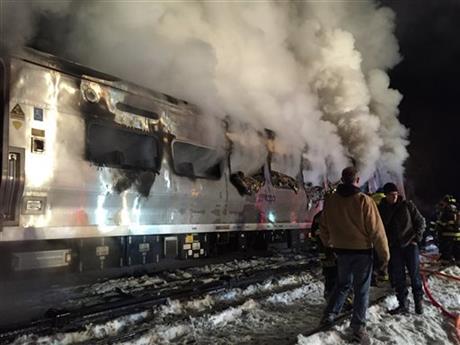
By JIM FITZGERALD and JENNIFER PELTZ
An investigation into what caused a fiery crash that killed a motorist and five rail riders is focusing on how a mother of three described by friends as safety conscious ended up between two crossing gates in her SUV as a commuter train barreled toward her.
“The big question everyone wants to know is: Why was this vehicle in the crossing?” Robert Sumwalt, a National Transportation Safety Board vice chairman, told reporters in suburban New York a day after the deadliest accident in the 32-year history of Metro-North Railroad, one of the nation’s busiest commuter railroads.
NTSB investigators were working Thursday to examine the tracks, interview the crew and find out whether Ellen Brody’s Mercedes SUV had a data recorder of its own.
Service on the Harlem Line resumed Thursday with delays, as trains slowed down through the crash site area.
Brody, 49, was driving home from her jewelry-store job Tuesday night when a witness said she got out of her vehicle to check after a guardrail came down on top of it. She then got back into the car, driving forward onto the tracks just before she was struck by the train, motorist Rick Hope told The Journal News.
“She wasn’t in a hurry at all, but she had to have known that a train was coming,” Hope told the newspaper, adding he backed up and motioned for her to do the same.
The crash happened in the dark in an area where the tracks are straight but drivers exiting or entering the adjacent Taconic Parkway had to turn and cross them. Traffic also was backed up because of an accident on the parkway.
Investigators had no evidence the crossing gates weren’t working properly, but their examination was just beginning, Sumwalt said.
Brody was a mother of three grown daughters and an active, outgoing member of her synagogue. She was “not risky when it came to her safety or others,” said family friend Paul Feiner, the town supervisor in Greenburgh.
The crash was so powerful that the electrified third rail came up and pierced the train and the SUV, and the SUV was pushed about 1,000 feet, Sumwalt said. The blaze consumed the SUV and the train’s first car.
Sumwalt said the NTSB would also examine the adequacy of the train’s exits and the intensity of the fire, which investigators believe was sparked by the SUV’s gas tank.
In the first car, a man whose own hands were burned elbowed open the emergency exit latch, allowing some of the train’s roughly 700 passengers to escape, passenger Christopher Gross said on ABC’s “Good Morning America.”
The train’s engineer tried to rescue people until the smoke and flames got so severe that he had to escape, Westchester County Executive Rob Astorino said.
While officials did not immediately release any victims’ names, employers and family members confirmed that the dead included Walter Liedtke, a curator of European paintings at the Metropolitan Museum of Art, Eric Vandercar, 53, a senior managing director at Mesirow Financial, Aditya Tomar, 41, who worked in asset management at JPMorgan, Robert Dirks, 36, a research scientist at D.E. Shaw Research in Manhattan, Joseph Nadol, an executive with JPMorgan Chase & Co.
It was not the first deadly crash at the site: A Metro-North train hit a truck, killing its driver, at the same Commerce Street crossing in 1984, according to Federal Railroad Administration records.
Every day, trains travel across more than 212,000 highway-grade rail crossings in the U.S. There are an average of 230 to 250 deaths a year at such crossings, down over 50 percent from two decades ago, FRA figures show.
Risky driver behavior or poor judgment accounts for 94 percent of grade crossing accidents, according to a 2004 government report.
Metro-North is the nation’s second-busiest commuter railroad, after the Long Island Rail Road, serving about 280,000 riders a day.
Late last year, the NTSB issued rulings on five Metro-North accidents in New York and Connecticut in 2013 and 2014, repeatedly finding fault with the railroad.
Among the accidents was a 2013 derailment in the Bronx that killed four people, the railroad’s first passenger fatalities. The NTSB said the engineer had fallen asleep at the controls because of a severe, undiagnosed case of sleep apnea.
___
Associated Press writers Kiley Armstrong, Ula Ilnytzky and Meghan Barr in New York; Joan Lowy in Washington; and Michael Kunzelman in Baton Rouge, Louisiana, contributed to this report.



